Centos Web Panel is the free Linux web hosting control panel used to provide quick, secure, and easy web management without any requirement of SSH consoles. It is mostly used by VPS and dedicated servers as it is designed to control various domains with the help of a centralized module for easy management.
It supports virtual connectivity through the detection of URL addresses. It provides the services of Server settings, Service SSH, Configuration, User Accounts, Domain Management, File Management, and many more.
By using it, users can easily migrate from the control panel account to a modern one within a few clicks. Simple steps need to be followed in order to shift the server management work from cPanel to Centos Web Panel. After the shifting of this platform, users will be able to enjoy the new state of the modern control panel.
Why Do Users Want Centos Web Panel Alternatives?
Centos Web Panel is the best in its field of proving quick, easy, and secure management of Linux web hosting control panels. It is highly compatible with third-party applications and supports native packages for DRBD, which ensures high availability.
It works ideal in the environment of code development. Along with the advantages, some shortfalls also exist in it as it has no structured user-friendly interface, and there exist some security issues as well. It is not suitable for the GUI of Linux distribution. It includes C++ libraries, so most of the time, it is difficult to understand.
List of Centos Web Panel Alternatives
It has many advantages as it provides fast, secure, and reliable management of Linux web hosting control panel. It is best for managing the DNS Zones and Templates. It includes the features of Web Servers, DNS Management, User Management, Email, and SQL database management.
In regard to these best functionalities, the following Centos Web Panel are selected and explained thoroughly, along with their structure and working techniques. Their merits and demerits are also provided, which helps the audience in choosing the best possible alternative of Centos Web Panel.
1. cPanel
CPanel is a hosting platform used to provide first-class support and services of web hosting. It is a reliable and effective hosting panel that offers virtual private or dedicated servers to all of its hosting accounts. The main benefits are that it guarantees 100% uptime and offers great solutions for web servers, and is easy to set up.
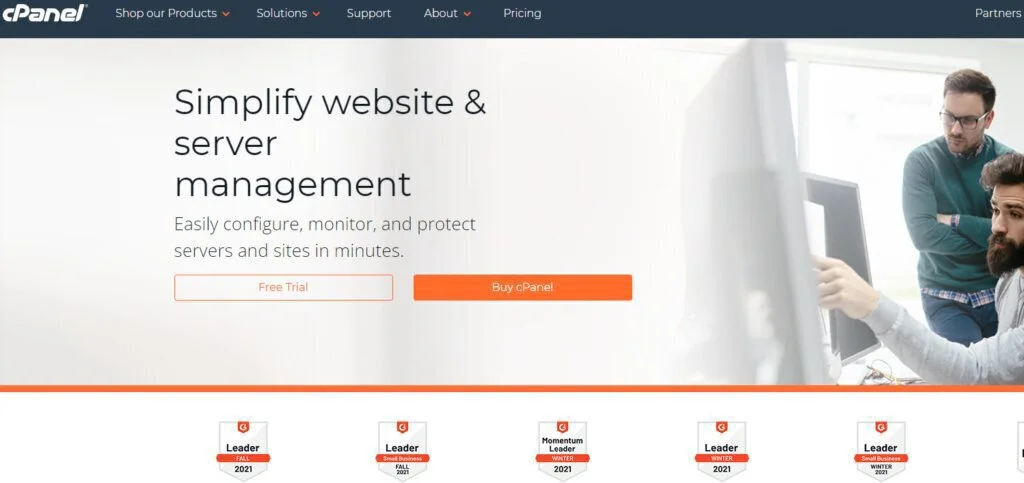
It supports seamless migration and is used to manage two separate solutions of web servers. It is helpful in increasing server efficiency and improving stability. Directories Password Protection, Email Account Creation, and Setting up Domains can also be possible by using this platform.
Features
- Website Logs
- File Management
- Protect Investment
- Database Management
- Setting up Domains
Pros
- Supports Softaculous Integration
- Easily WordPress Spin-up
- Flexible and Secure
- Speed Improvement
- Domain Name Management
Cons
- Problematic WordPress Installation
- Email Client Offering
- Limited Dashboards Customization
- Complex Design
- No Live Support
2. Vesta
Vesta is an open-source hosting control panel used for the configuration of Low, medium, and High RAM servers. It includes a fast web interface and displays all the services that are currently working. Domain creation and deletion can also be possible within a few clicks.

It allows its users to check the current load and bandwidth of the computer that is currently utilized. It is used in SSL certification support, SNI Certification support, Wildcard support, and Template configuration. It works faster with the help of keyboard keys and ensures data security.
Features
- File Manager
- Databases Management
- Web Domain
- Proper Back-Up Facility
Pros
- Fast Data Back-up
- Easy to Manage Servers
- Monitoring System
- Open Source
- Simple and Convenient
Cons
- Paid Technical Support
- Not Suitable for Resellers
- Issues in SSL Console
3. ZPanel
ZPanel is a free and open-source web hosting platform that supports the operating system of Windows, Linux, and Mac. It is written in PHP language and uses different open-source software packages to provide a secure and robust web hosting system.
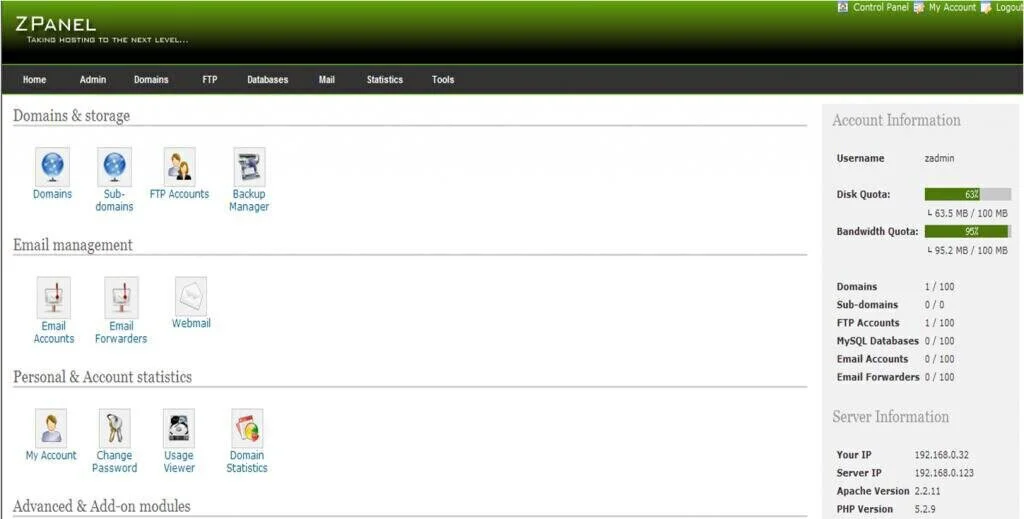
It uses an advanced management solution that helps the system to migrate home or business servers into an easy-to-use, manageable, and full-fledged web server. It provides different solutions to automate all the hosting issues, whether it is web-based, email, or database.
Features
- Website Builder
- LAMP and VPS
- Web Servers
- Web Hosting
Pros
- Fast Services
- Unlimited Disc Space
- Customization Option
- Large Bandwidth
Cons
- Poor Customer Support
- Limited Integration
- Issues in Managing Servers
4. DirectAdmin
The DirectAdmin control panel is the web hosting control panel similar to cPanel that allows its user to administer the website with the help of the graphical and web-based interface. It is easy to understand and is best for beginners. It let its users stay updated with its latest updated version available on the internet.

It has a user-friendly interface that allows its users to manage their website with ease. It also supports multiple languages and contains unlimited domain licenses. It offers fast services, stability, and flexible licensing options. It is considered a powerful server and website administrator as it can run the servers worldwide.
Features
- MySQL Database Management
- DNS Administration
- User Stats
- File Manager
- FTP Menu
Pros
- Easy to Use
- Fast Speed
- Good Customer Support
- Flexible Licensing Options
- Support Multiple Languages
- Easy Migration
Cons
- Limited Resources
- Issues in Integration
- Lack of Plugins
- Less Documentation
5. Webmin
Webmin is a web-based tool specially designed for UNIX operating systems. It is applicable on any kind of browser with the help of the File Manager Module. To keep the system updated, it uses a web server and CGI program files. By using it, users will be able to change the setting with a single click.
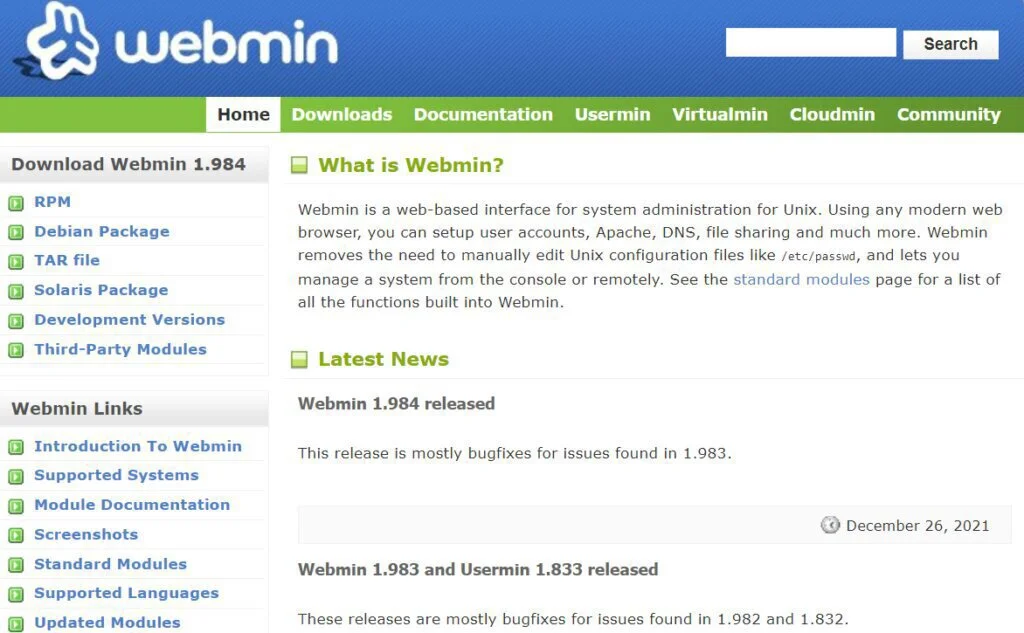
It is also helpful in managing the group of software packages easily. It is available in different links such as Actions log, Configuration, Server index, and WebMine users. These links can also be used to access various editable options. It supports the integration of MySQL, Debian, Feora, and AlertOps.
Features
- Bug Tracking
- Solaris Packing
- Third-party Modules
- Tar Files
- Alerts and Notification
Pros
- Support Multiple Languages
- Develop Modules
- Modify Ports and Usage
- Easy to Use
Cons
- Limited Integration
- Paid Subscription
- Issues in Modification
6. Plesk
Plesk is the commercial web hosting platform used to automate various tasks and is able to process them on single or multiple servers. It is used by system administrators to set up new websites, email accounts, DNS, and databases with the help of web browsers.
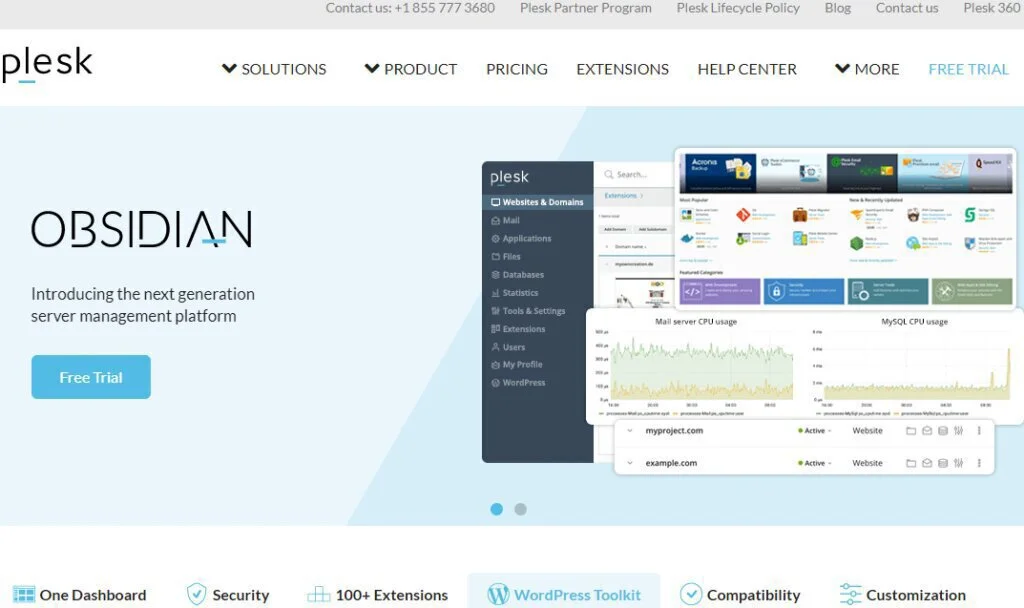
It supports Windows Server 2012 R2, and to install it on the windows operating system, a static IP address is required. By using this platform, system administrators will be able to manage a website for their employers, businesses, or for themselves.
It is a multi-functional hosting control panel that helps the users to build their own control panel with a graphical user interface. It supports powerful extensions and plugins as it includes all the required development purposes that are helpful in the growth of the business.
Features
- User Interface Administration
- Mobile Browser Support
- Website Back-ups
- Advance Migration Tools
- Self-Repairing Tools
Pros
- Secure Server
- Email Security Pack
- Integrated Plugin
- Website Administration
Cons
- Issues with Google Account
- Terrible Customer Support
- Confusing Dashboard
- Slow Loading Speed
7. Kloxo
Kloxo is an open-source, free web hosting platform for the distributions of Linux and CentOS. It allows the administrators of both the servers and hosts to operate as a combination of Apache or Lighttpd with the Bind or djbdns. It has a graphical user interface that helps multiple programs to switch without losing data.
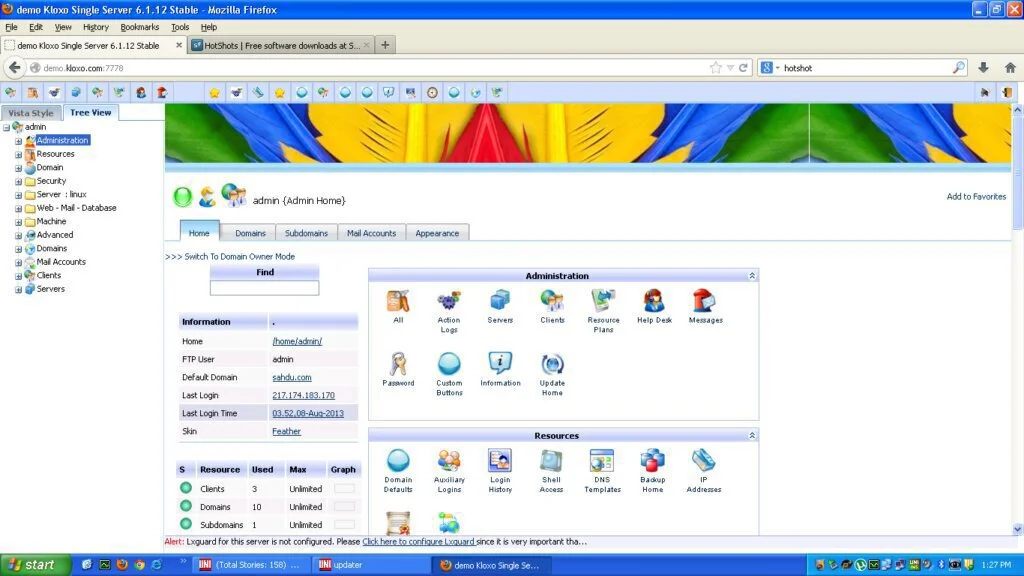
It allows the transformation of one Apache-based server to another Lighttpd-based server. It highly supports the third-party application name Installatron and mostly works as a plugin. IT supports, it also helps to handle different kinds of servers along with their features. It is easily integrated with more than 130 web applications.
Features
- Web Servers
- PHP Version
- Error Detection
- File Manager
Pros
- Ability to Block Hosts
- Access to Queue Mail
- Web-based Interface
- SSH Configuration
Cons
- Issues in Ports
- Default Password
- Problems in User-add String
- Poor Customer Support
8. ISPConfig
ISPConfig is the control panel hosting platform that has the ability to manage multiple servers from a single control panel. It is used as the webserver management of both Apache2 and Nginx. It supports mail server management with the help of its virtual mail users.
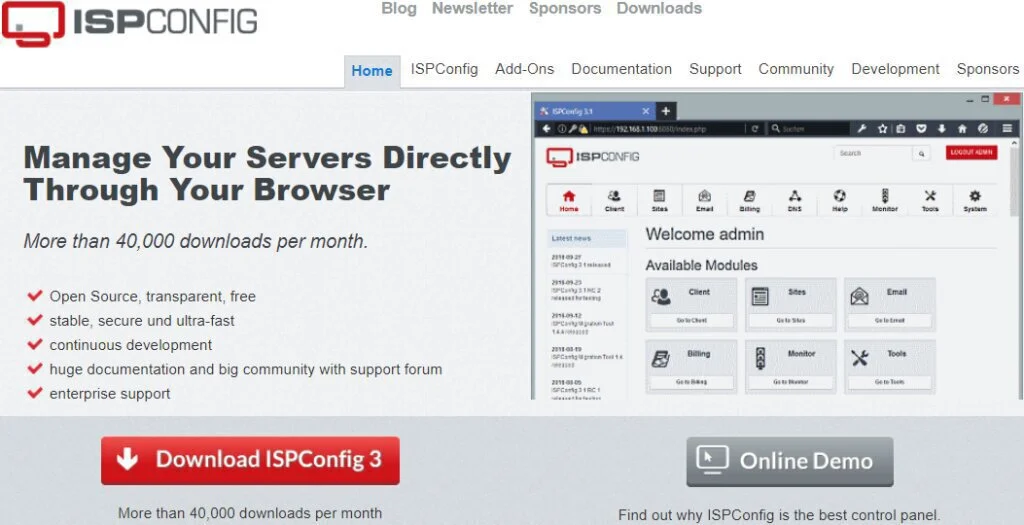
By using this platform, users will be able to enjoy multiple access levels like administrator, client, and reseller. It provides services to different platforms like SMTP, HTTP, BIND, MyDNS, and many more. The best part of this control panel is that it is open-source, secure, and ultrafast, along with continuous development.
Features
- Manage Multiple Servers
- Supports Daemons
- Supports Linux Distributions
- MySQL Database Management
- DNS Servers
Pros
- Folder Password Protection
- Supports Multiple Languages
- Friendliest User-Interface
Cons
- Web Traffic Limitation
- Poor Customer Support
- Issues in Integration
9. EHCP
EHCP is the free and open-source hosting service provider that is used along with the control panel. EHCP stands for “Easy Hosting Control Panel” that hosts its own website and works with the particular domain name in order to survive in the market. It is easily integrated with Debian Operating System as well as Ubuntu.

It is a tool that is used to facilitate the process of emails, adding domains, FTP user and hosting domains, etc. It is simple and light-weighted. It provides the services of Unlimited FTP Users, Unlimited MySQL Database, Web Statistics, Web FTP, Domain Management, Password Protected Domain, and many more.
Features
- Ubuntu Supported
- Transferring Domains
- Supports Multiple Server
- Apache SSL Integration
- Unlimited Domains and Resellers
Pros
- Email Forwarding
- Easy to Use
- Customizable Templates
- Supports Multiple Languages
Cons
- Limited Integrations
- Paid Subscription
- Slow Processing
10. Virtualmin
Virtualmin is an alternative to Centos Web Panel that is designed to support Linux and BDS systems. It is free and open-source cloud control and web hosting platform that is used to manage single and virtual hosts from a single user interface.
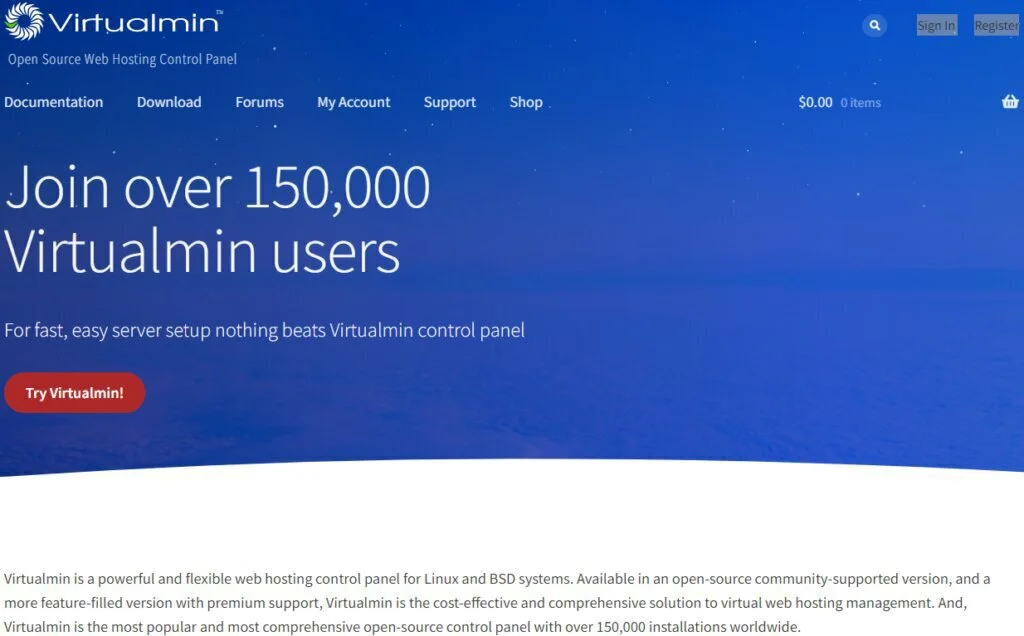
Its main benefit is that it provides a flexible and powerful hosting control panel. It has a command-line interface along with unmatched security features as it supports a command-line interface, so it is not suitable for beginners. It offers cost-effective and comprehensive solutions to all the issues of virtual web hosting management.
Features
- System Administration
- Web Hosting
- Cloud Integration
- Reseller Accounts
- Domain Accounts
Pros
- Fit for Low RAM Servers
- Open Source
- User-Friendly Interface
Cons
- Does Not Support Linux
- Paid Subscription
- Security Issues
- Limited Platform Integration
11. Ajenti
Ajenti is the web-based Linux server administration panel for managing instant remote access at any time with the help of a web terminal, text editor, and file manager, etc. It requires an on-time installation process eliminating the need for tools or add-ons.
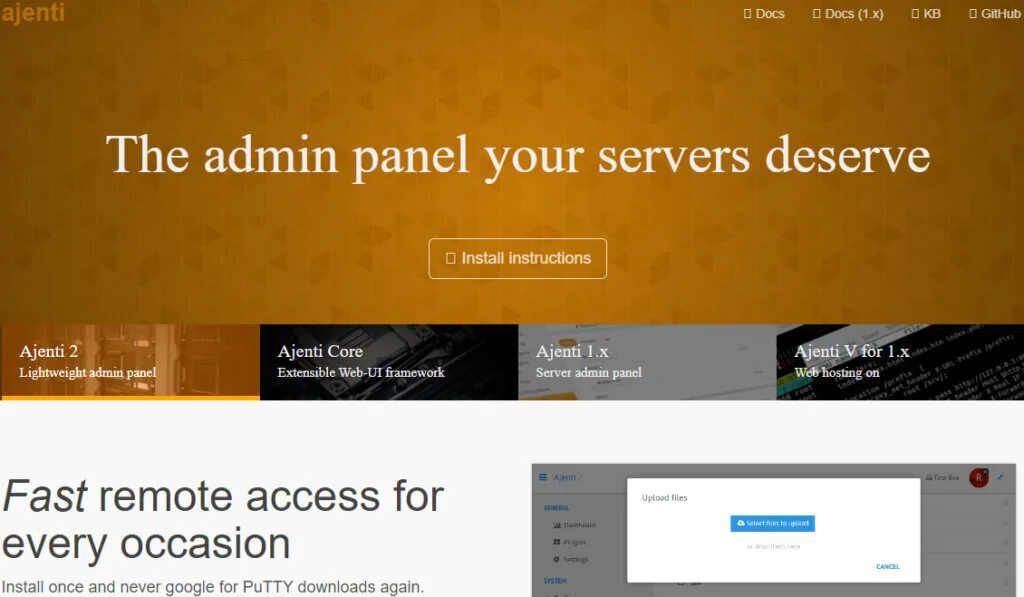
It provides a fast and secure method to manage any kind of remote Linux box. Its main advantage is that it has the ability to access the server from anywhere in the world from a remote terminal. It is fully supported by JS and Python languages.
It offers the best solution in case of complex VPS schemes and uses managed VPS programs o limit administrative rights. It is also helpful in solving the reseller’s and customer’s issues like administration, permission modification, editing Apache virtual host rules, and many more.
Features
- Shared Folders
- System Administration
- Custom Widgets
- Security Firewall
- NGINX Server
Pros
- Free to Use
- Compatible with Host Accounts
- Easily Integrated with Servers
- Support Multiple Languages
Cons
- Not Good for Beginners
- Complex Interface
- Difficult to Understand
- Confusing Dashboard
12. Froxlor
Froxlor is the fast processing and lightweight server controlling platform that is used to manage the day-to-day server requirements. It is used to manage the administration software according to the needs of customers like IPS, domains, SSL, email databases, and many more.

It includes the features of an advanced multitasking system, PHP configuration system, traffic calculation, and many more. It is helpful from managing the business servers to managing resellers and customer resources. It provides the best solution for hosting management systems because of its scalable management feature.
Features
- PHP Configuration
- Traffic Calculation
- Multi-Tasking System
- Theme-able Interface
- Data Encryption
Pros
- User-Friendly Interface
- Easy to Use
- Simple to Navigate
- Open-Source
Cons
- Confusing Technical Terms
- Poor Customer Support
- No API Access
- Limited SSL Ports
13. Hepsia
Hepsia is the web hosting control panel that is used to manage multiple websites along with their domain name from a single location. It is considered the most advanced control panel to manage multiple domains and hosting-related issues.
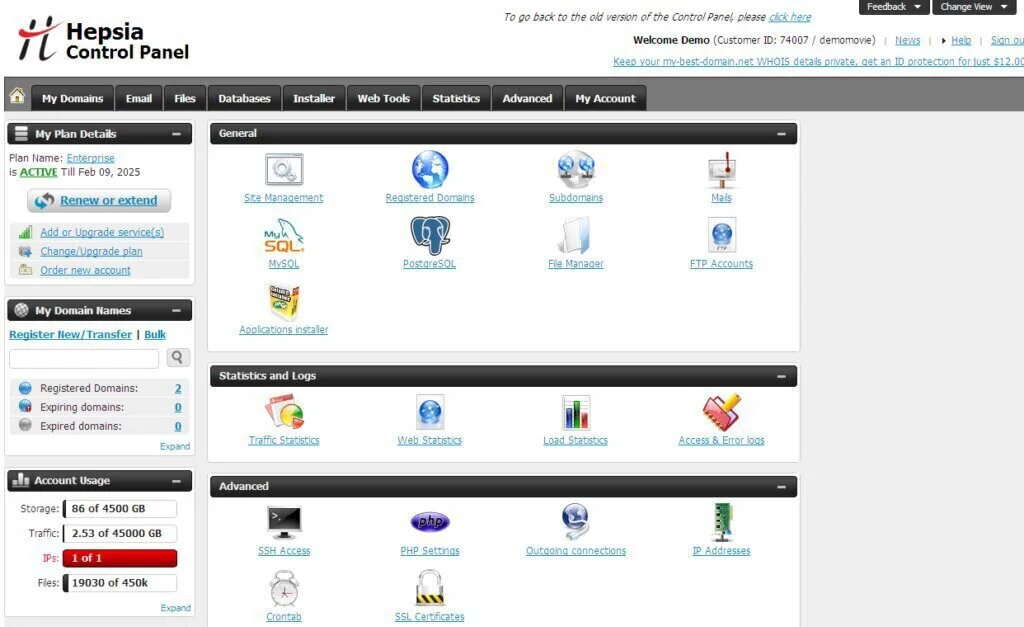
It includes a drag and drop panel that helps the users to manage all the domains easily. Its four main benefits are its intuitive interface, mobile version, full site control, and ability to manage all the tasks from smartphones. It has the ability to manipulate sites in order to handle multiple commands by creating a separate server.
It is basically designed to enable the common users to handle multiple accounts at the same time. It provides the facilities of drag and drop of file management, PHO-based web application, password integration, and many more.
Features
- Web Applications
- Data Encryption
- Password Integration
- MoD Security Firewall
- No Code Modification
- PHP Configuration
Pros
- Intuitive Interface
- Full Site Control
- Developers Tools
- Mobile Version
Cons
- Security Issues
- Limited Integration
- Issues in Domain Adjustment
14. BlueOnyx
BlueOnyx is a web hosting platform used to provide fully integrated online hosting platforms such as emails, web, and file transfer services. It is a web-based management platform, so the server administrator needs not download and install it. By using it, administrators have the ability to host unlimited numbers of virtual sites and users.
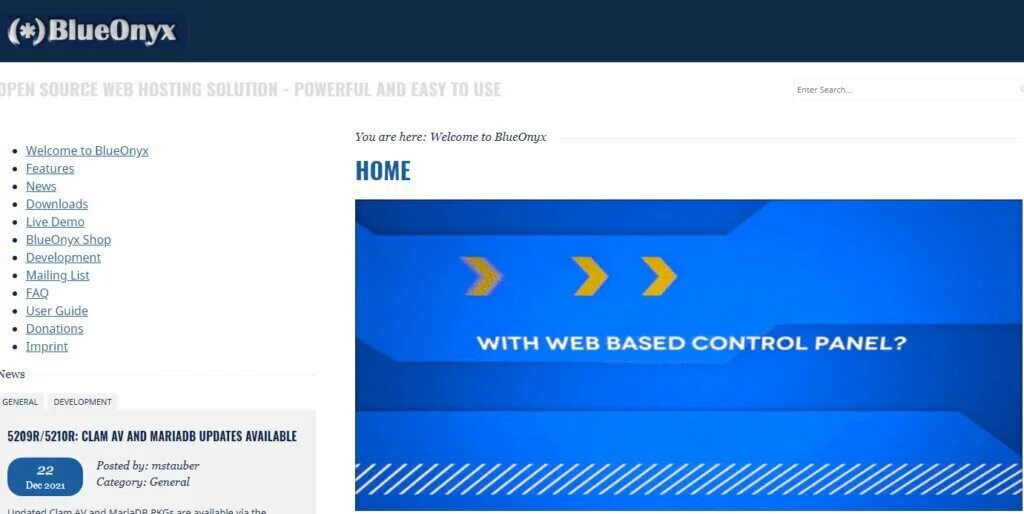
It is also an open-source platform and is available free on the internet along with all of its services and functions. It is the best solution for the server administrators of Linux as they allow virtual hosting along with their control panel. It helps in reseller management in order to allow resellers to create users and virtual sites.
Features
- Dual-Stack Support
- Reseller Management
- Server Name Indication
- NGINX SSL Proxy
Pros
- Graphical User Interface
- Easy to Install
- Multiple Access Control Levels
- Docker Integration
Cons
- Some Features Not Working
- Limited Plugins
- Issues in Transferring Files
15. SeekaHost
SeekaHost is an alternative to Centos Web Panel that is used to provide hosting services to all the blog networks. It is designed to fulfill all the SEO needs of the hosting platforms with the help of completely natural profiles. Its free trial is available for a period of 7 days, and its starting price is $1.49 per feature per user.

It offers different class IP addresses and assigns isolated DNS servers to each of their domains along with free SSL certification and HTTP setup. In this platform, every server is configured to performance mode, so there is no need to install any security plugin.
By using this platform, users will be able to log into any blog from the dashboard, and no username or password is required for authentication. It provides the best solution to automate hosting services without the anxiety of maintenance.
Features
- One-Click Installer
- Complete Security
- Fully Manages Server
Pros
- User-Friendly Interface
- 24×7 Support
- Easy to Use
- Fast Hosting WordPress Sites
- Easy to Transfer
Cons
- Steep Learning Curve
- Shared Hosting
- Slow Processing
16. SolidCP
SolidCP is the comprehensive management portal that is used to handle multiple domains in order to make a centralized cluster of various websites with the help of a command-line server. It is a free and open-source multiple server that allow its users to control and manage unlimited servers at the same time.
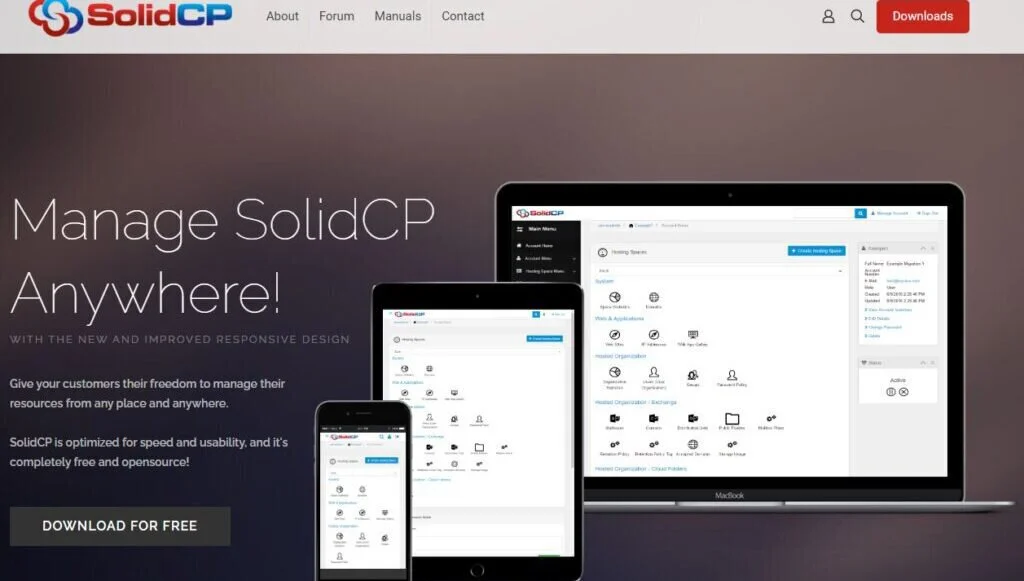
It supports clustering and helps the administrators to resolve the management issues on a centralized platform. It will let their client’s free hand manage the resources as it is a free and open-source server, so it helps the server administrators to optimize the speed and usability of the system simultaneously.
The best thing about this platform is that it is easily integrated with all the major hosting platforms and simplifies the overall management work. The main aim of using this platform is to create a control panel with a combination of Windows and Linux.
Features
- Responsive Design
- Multi-Server Panel
- Web Hosting
- Extensible by Plugins
- System Administration
Pros
- Free to Use
- Community Driven
- Manage System from Anywhere
- Integrate with Major Enterprises
- Automatic Setup
Cons
- Confusing Dashboard
- Limited Features
- Issues in Updating System
- Problems in Integration
Final Words
In this article, Centos Web Panel is discussed in detail. Centos Web Panel is the free Linux web hosting control panel that is used to provide quick, secure, and easy management without the requirement of SSH consoles at all.
Along with the advantages, some shortfalls also exist in it as it has no user-friendly interface, and there exist some security issues as well. It is not suitable for the GUI of Linux distribution. It includes C++ libraries, so most of the time, it is difficult to understand.
To overcome such issues, many the alternatives are available in the market. Some of the alternatives are discussed here, along with their features, pros, and cons. After discussing the article, it is concluded that SeekaHost is best to use because of its extensive features.














